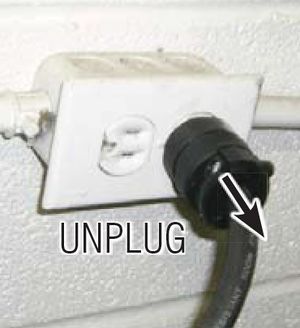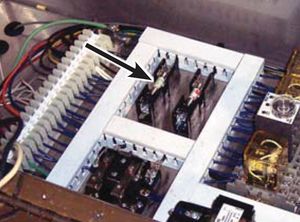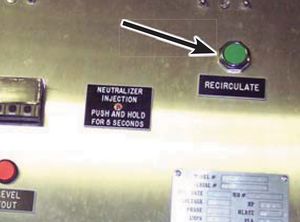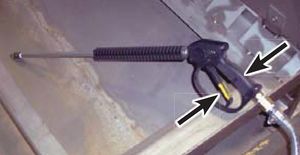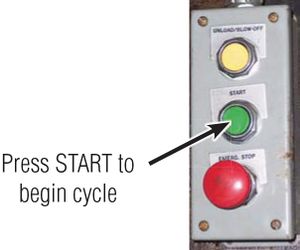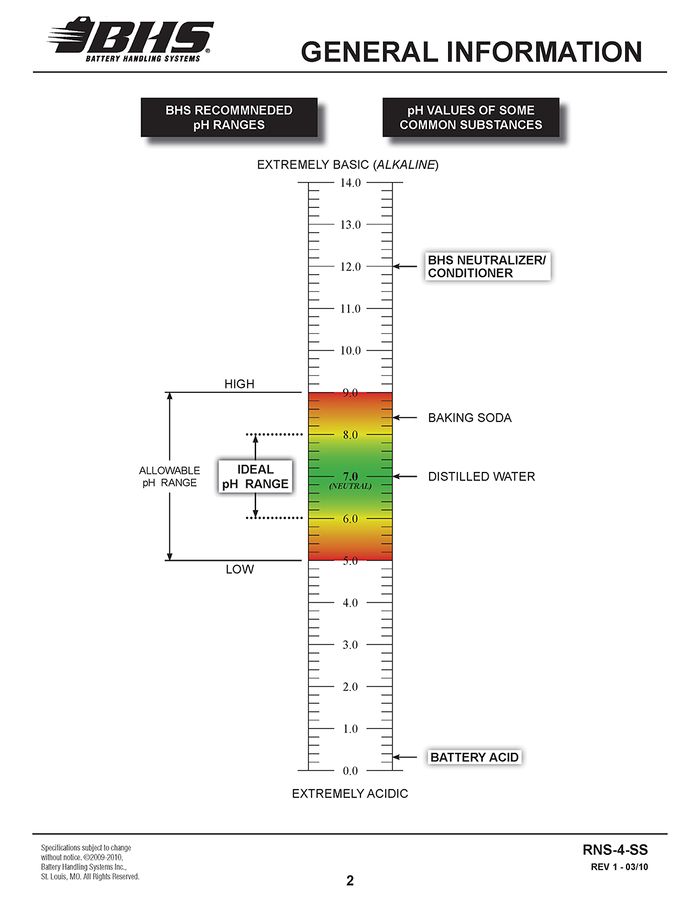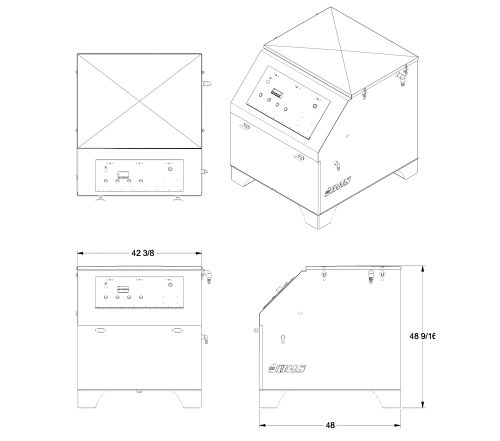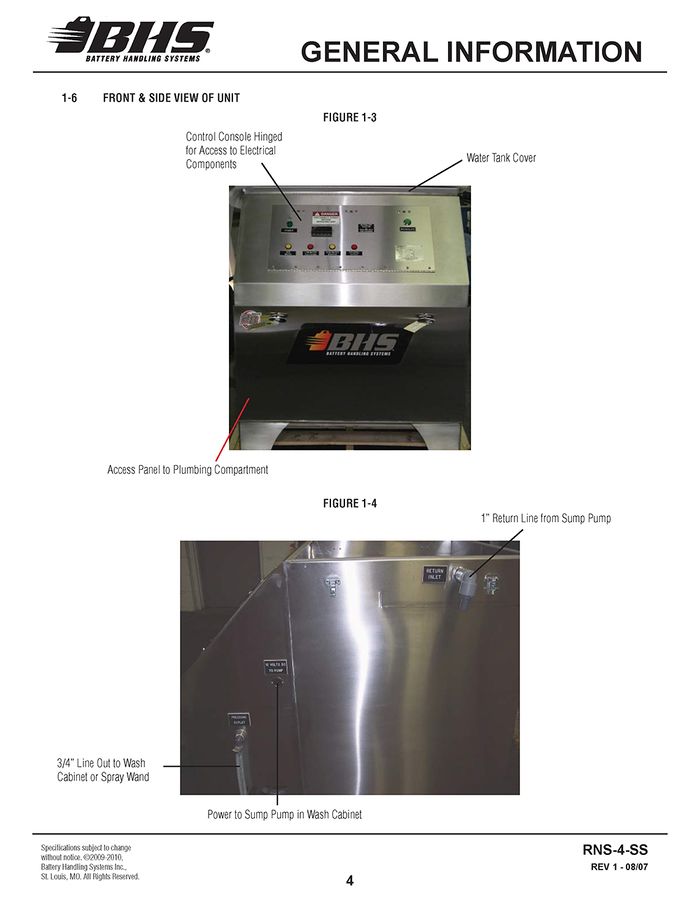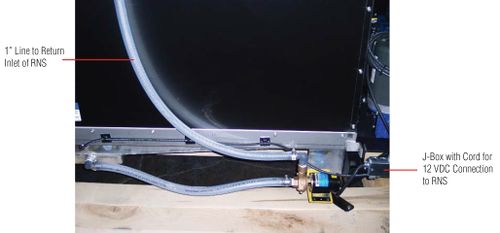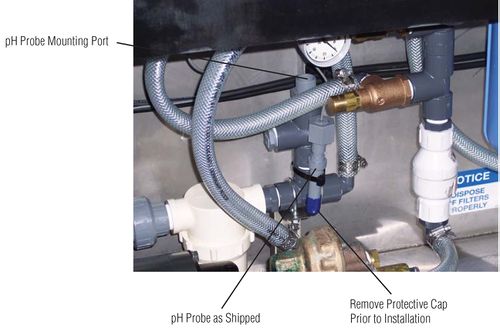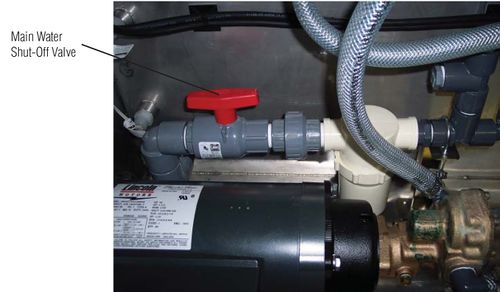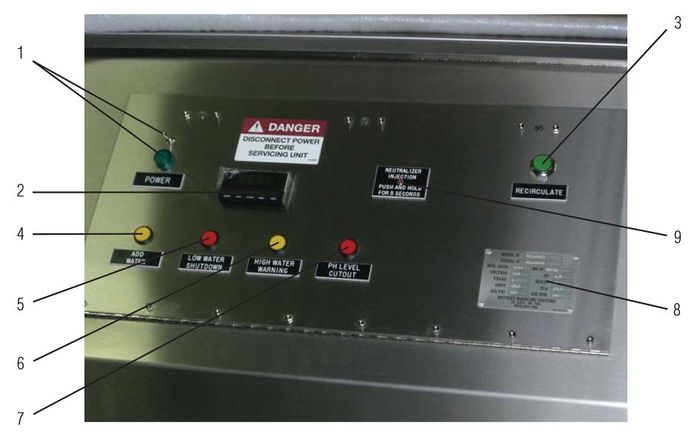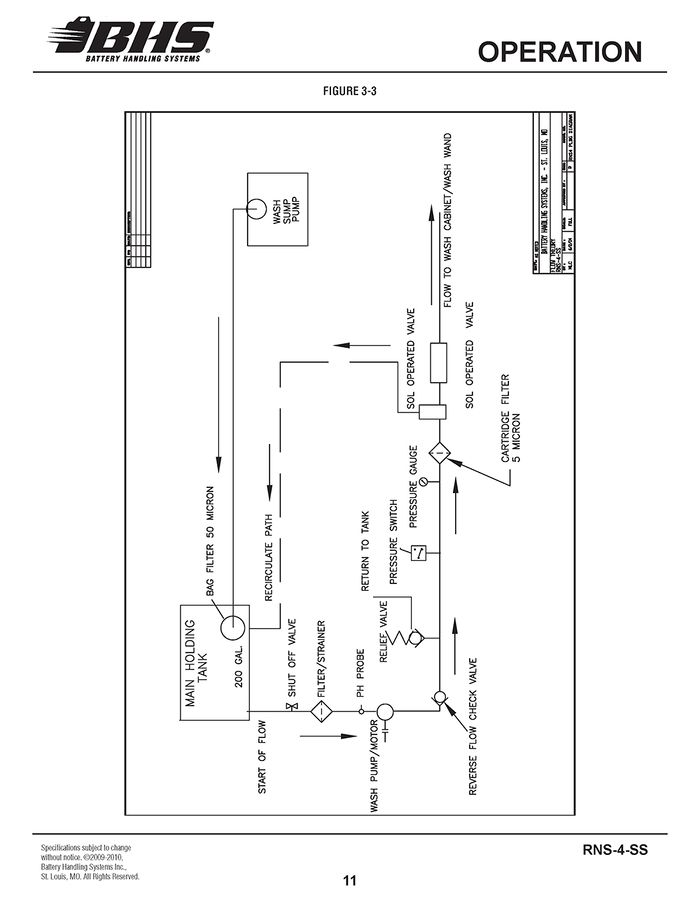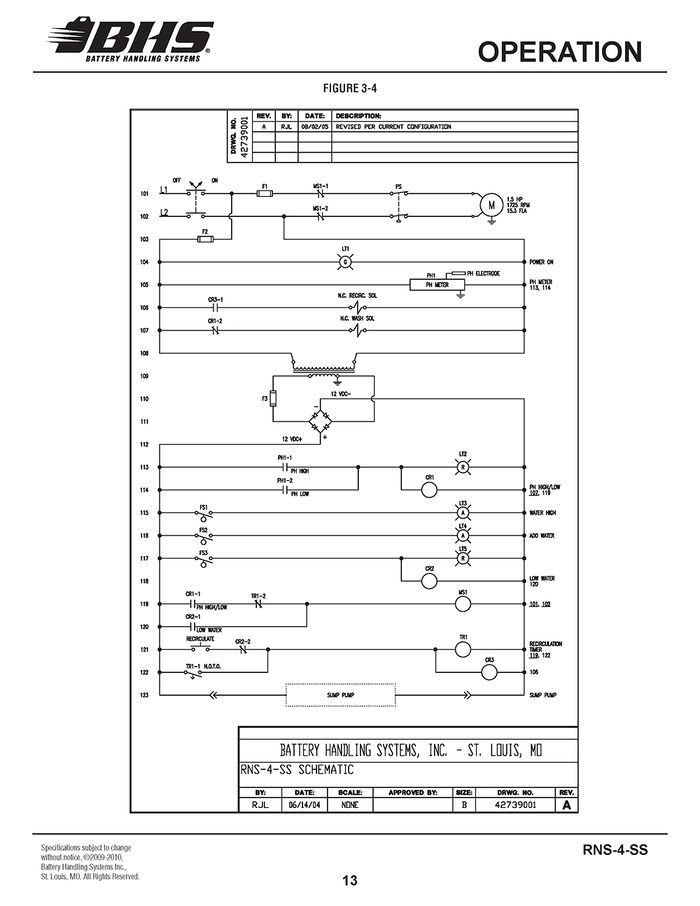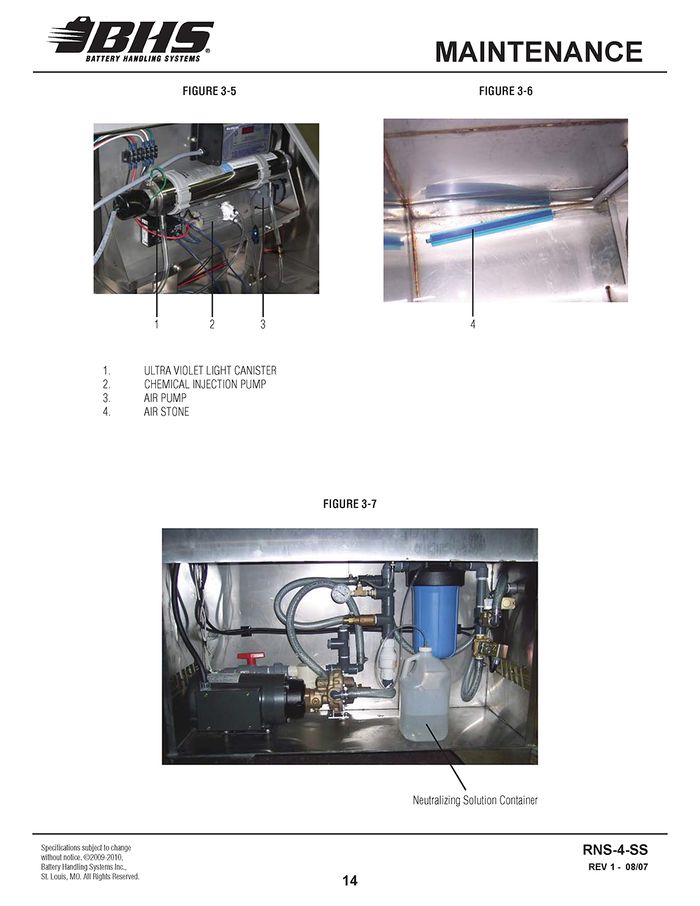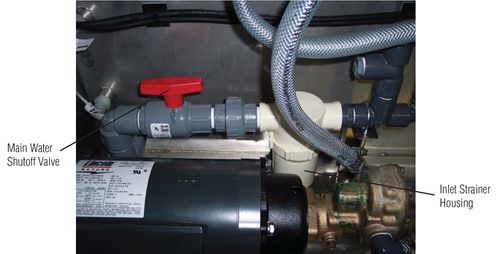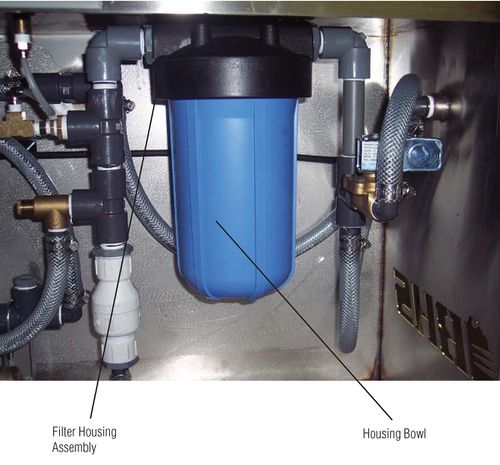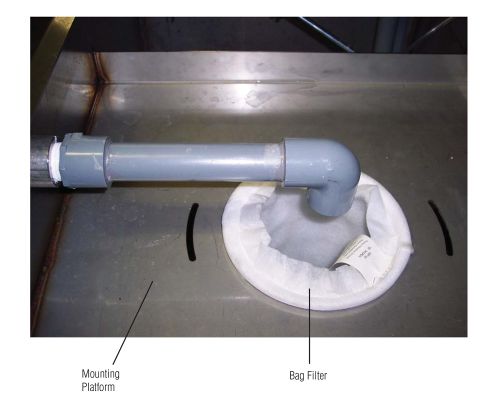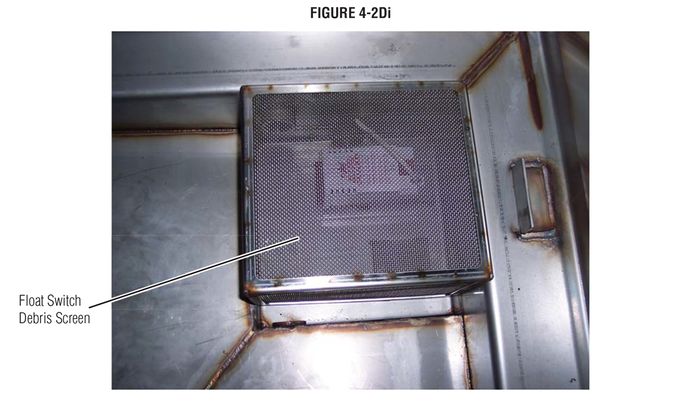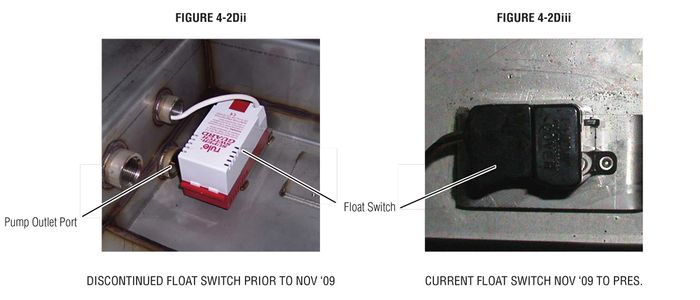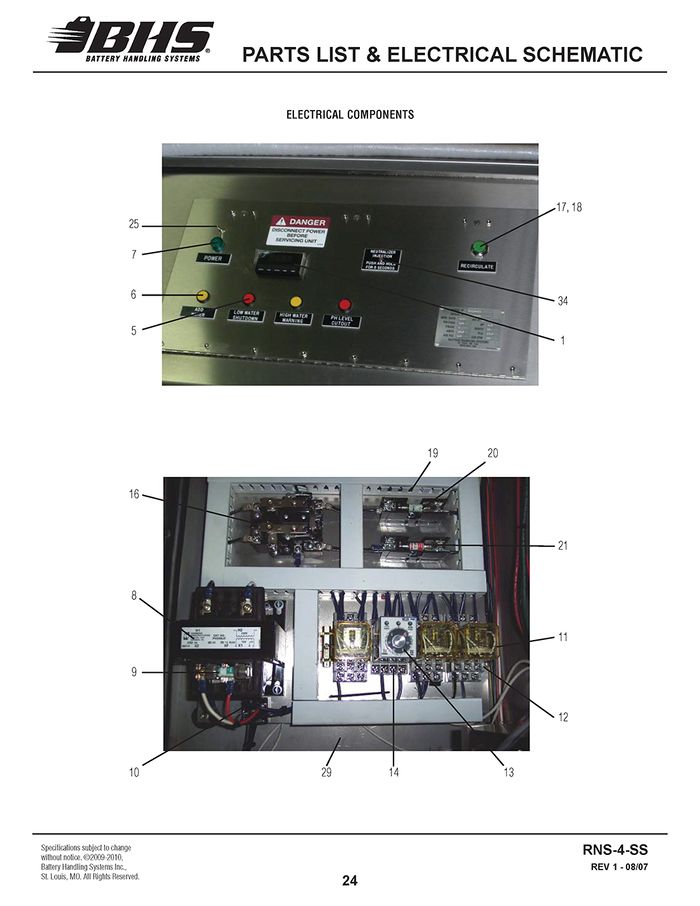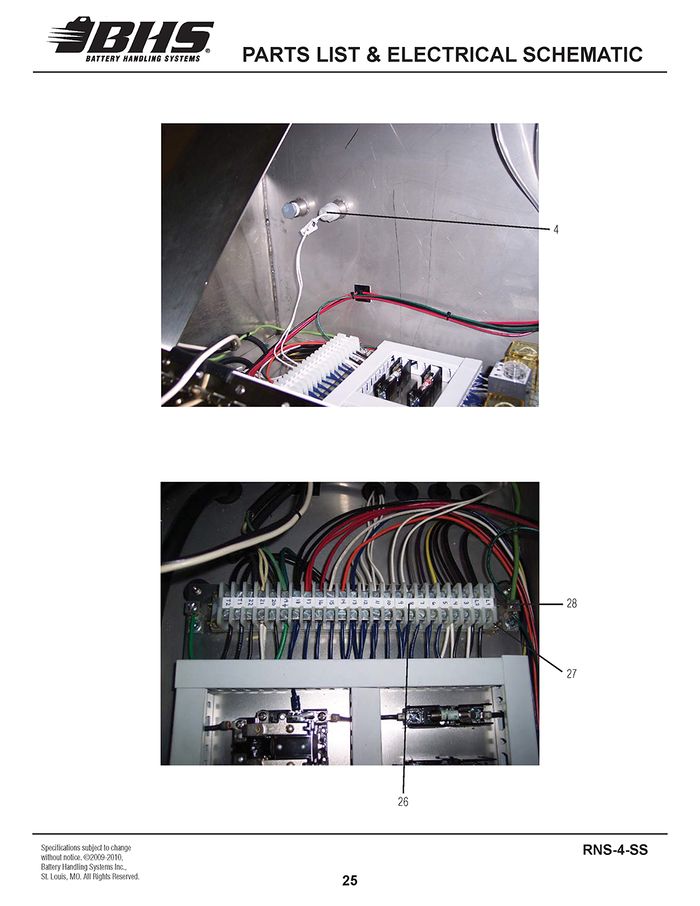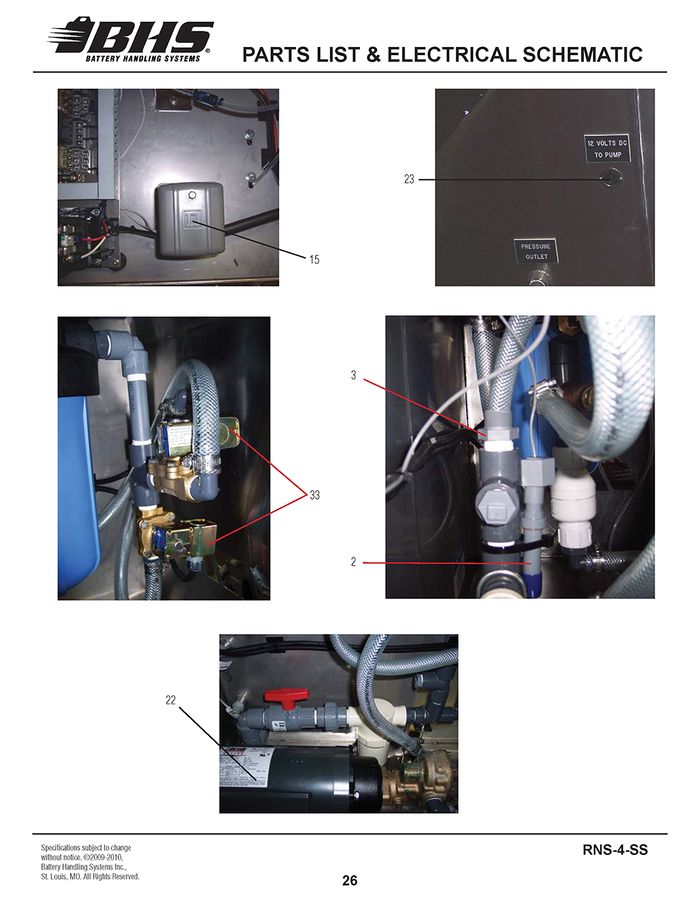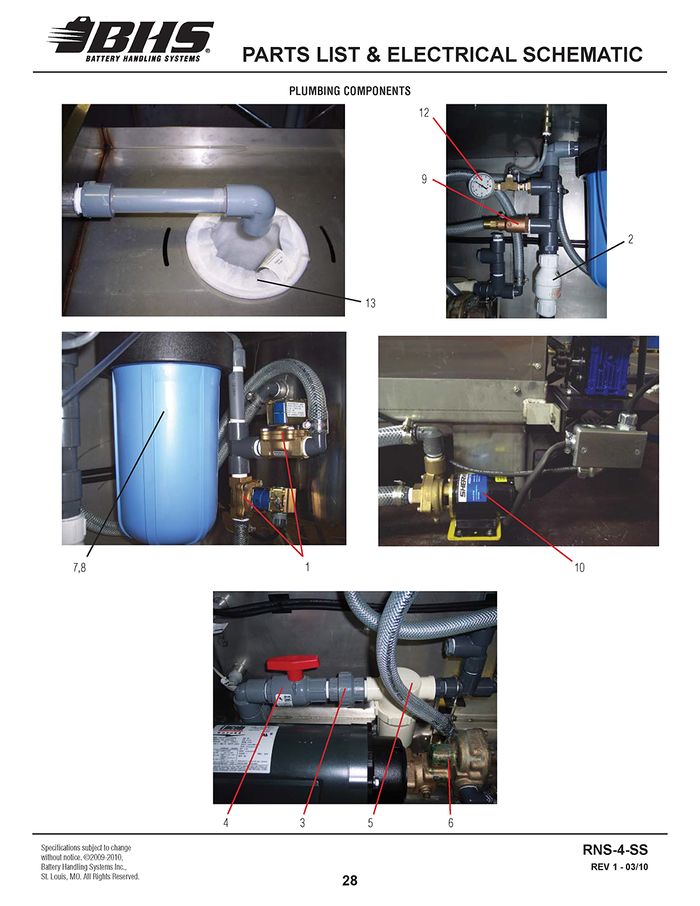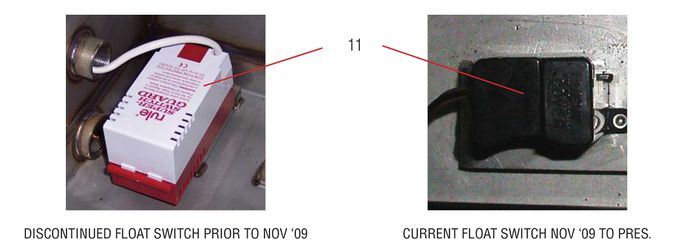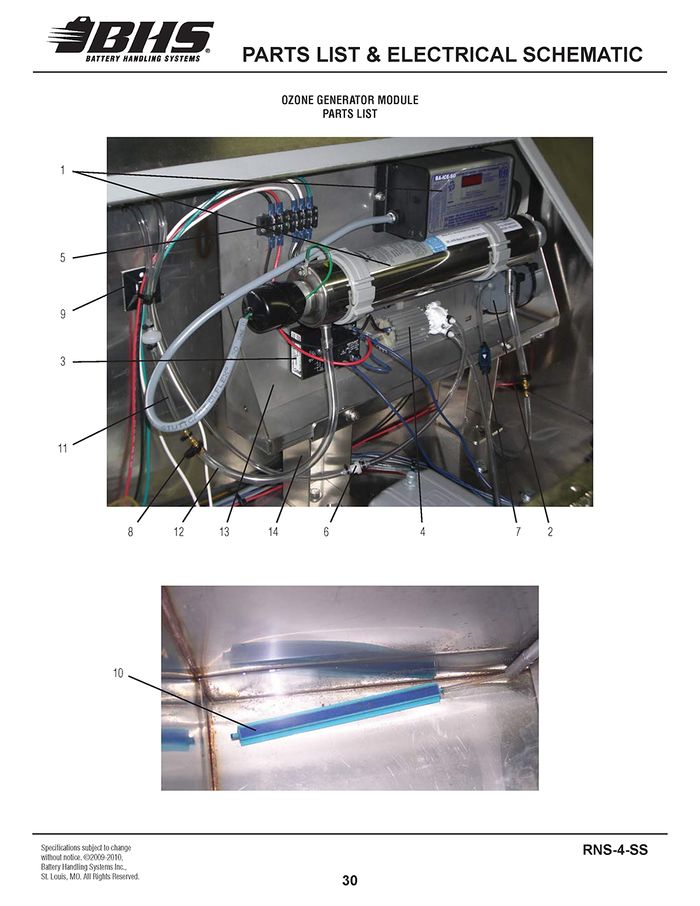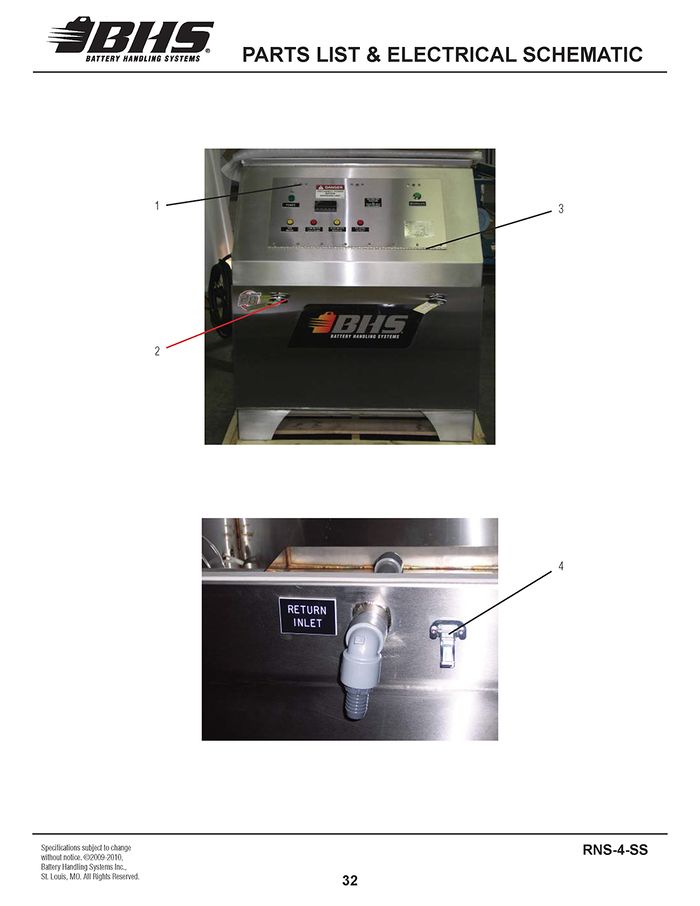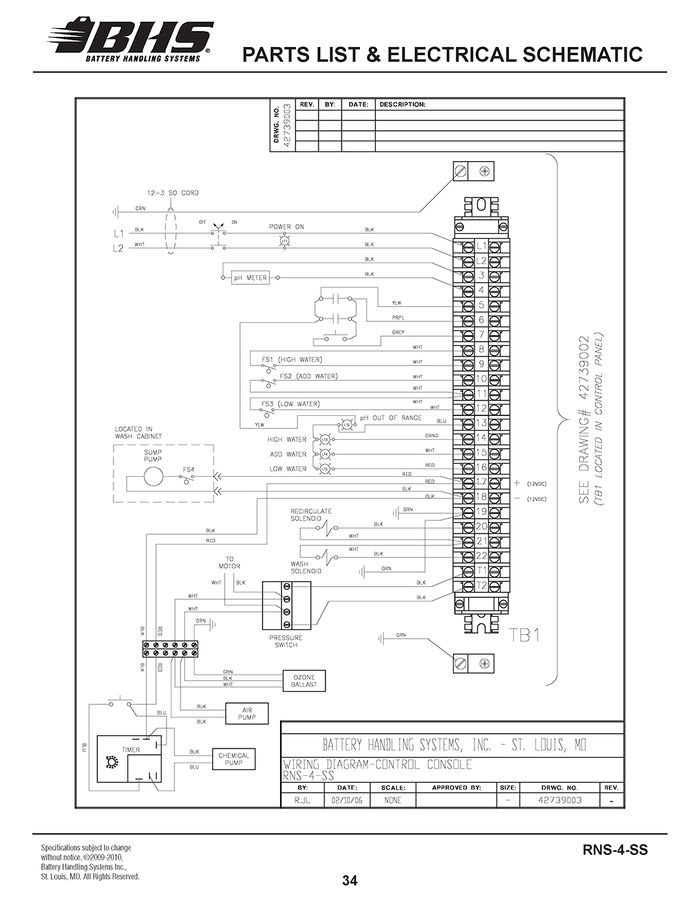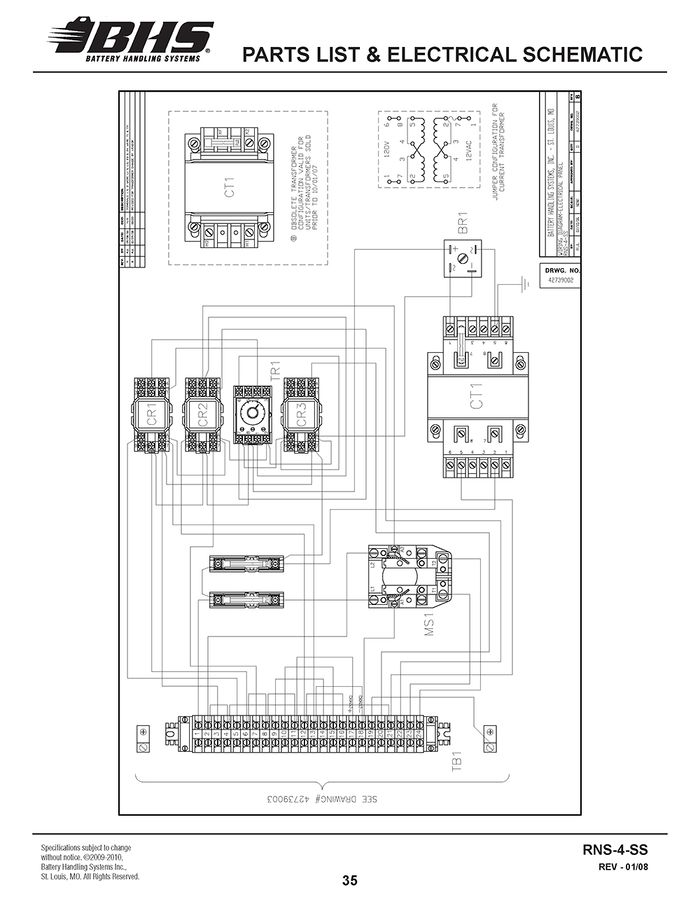IOP-426 RNS-4-SS
Looking for a specific replacement part? Ctrl-F (or Command-F for Mac users) brings up your browsers search panel and can search any text on the entire web page. Find parts by searching a part # or part description.
Register your equipment with BHS Optima, BHS's free app.
California Residents: WARNING: This product contains chemicals known to the State of California to cause cancer and/or reproductive harm, and birth defects or other reproductive harm. Learn more here.
Recirculation/Neutralization System, Stainless Steel, 200 gal, Auto pH Monitoring (RNS-4-SS) Parts & Service Manual
TP-602 - SAFETY AND DE-ENERGIZATION PROCEDURES
GENERAL SAFETY
- Read and understand all instructions and warnings before using or servicing this equipment.
- Keep these instructions for future reference.
- Follow all federal, state and local requirements for handling and treatment of battery wash cabinet effluent.
- Recirculation/Neutralization System (RNS) units are not designed to be shipped or transported after initial delivery.
- A licensed structural engineer should be consulted prior to installing a RNS on any building level other than the ground floor.
- Perform system and safety check before operating.
- Failure to follow these instructions and warnings may result in property damage, personal injury or death.
WORK AREA
- Keep work area clean and well lit. Cluttered work areas and poor lighting can lead to accidents.
- Clean up/contain any fluid spills immediately to prevent slips or falls.
- Be aware of potential hazards when performing any service or maintenance to the unit.
SERVICE & MAINTENANCE
Service personnel shall wear Personal Protective Equipment (PPE) appropriate for the task being performed.
LOCKOUT/TAGOUT
Lockout/tagout the RNS per your corporate policy, if damaged or not functioning properly. Lockout/tagout and deenergize all systems prior to performing any maintenance or service to unit.
LEAD-ACID BATTERIES-EXPLOSION HAZARD
Do not allow open flames or sparks of any kind near a battery. Highly explosive gas is generated when charging a battery that can remain in battery cells for extended periods of time after charging is complete.
- Always wear appropriate PPE including rubber apron, gloves, boots and full face shield when performing service or maintenance to any lead-acid batteries.
- Do not place metal or other conductive objects on top of battery. Arcing may occur causing damage to the battery and/or serious personal injury or death.
- Use only chargers matching the voltage and amperage of the battery being charged. Overcharging a battery can cause damage to the battery, charger and/or serious personal injury or death.
- Turn off charger before disconnecting battery from charger. Arcing between battery and charger connectors can cause damage to the connectors and/or serious personal injury or death.
BATTERY WASH WATER HAZARDS
HEAVY METALS:
Battery wash water contains heavy metals including (but not limited to) lead and antimony, which through prolonged exposure can lead to serious, long-term, adverse health conditions.
EXTREME pH LEVELS:
Highly acidic (low pH) as well as highly alkaline/ basic (high pH) solutions can cause severe burns, release toxic fumes, and cause violent chemical reactions when mixed with water or when mixed together.
- pH values outside of the BHS allowable range of 5 to 9 should be treated as “extreme” and caution should be taken to avoid direct contact with such solutions.
- Always wear appropriate PPE including rubber apron, gloves, boots and full face shield when working in contact with any battery wash water.
TREATMENT CHEMICALS:
Use of chemicals not approved by BHS to treat wash water may result in the release of toxic fumes.
OPERATIONAL SAFETY
OPERATIONAL SAFETY
- Only personnel trained in the proper and safe operation of RNS units may operate or service the RNS.
- Operators shall wear appropriate PPE suitable for working with industrial lead-acid batteries while operating the RNS (see prior page).
- All data plates, warning labels, placards, etc. shall be in place and legible at all times. Contact BHS for replacement data plates, warning labels, placards or instructions.
- All users and service personnel shall be familiar with the meaning and risks associated with all data plates, warning labels, etc.
- Remove the RNS from service if damaged, defective, or operating improperly (or becomes such while operating) until repairs can be made to correct any problem(s).
- Only use BHS approved chemicals in the RNS. Severe chemical and/or toxic reactions may result.
DO’s AND DON’T’s
- DO NOT overfill the RNS reservoir.
- DO NOT operate the RNS when reservoir is empty.
- DO NOT modify or fit the RNS with attachments without prior, written approval from BHS.
- DO NOT operate the RNS with any guard or cover removed unless required for maintenance or repair.
- Disconnect RNS from all power sources before attempting to perform service or maintenance to the unit.
- DO NOT immerse any body part into the RNS holding tank water.
- DO NOT use any chemicals in the RNS that are not approved by BHS.
- DO NOT use the RNS to wash anything other than industrial lead-acid batteries.
- DO NOT use foaming type detergents in conjunction with the RNS.
- DO NOT use soda ash or similar types of neutralizers.
- Use only liquid neutralizers.
- DO NOT spray personnel or electrical components with spray wand (if equipped).
- DO NOT use the RNS in a manner for which it is not intended. Some examples of prohibited use are but not limited to:
- As an emergency wash station
- As a parts washer
- As a battery room wash-down device
- As a battery acid disposal device
DE-ENERGIZATION
- Turn off and disconnect power to the RNS. (Note: The green power light will go out). See Figures 1.1 & 1.2.
- Open the control panel door and remove the 17.5A fuse (the left most fuse) from the control board. See Figure 2.
- Reconnect power to and turn on the RNS.
- Press the RECIRCULATE button to activate the recirculation cycle (default time is 20 minutes). Turn off the RNS after 10 seconds. See Figure 3.
- If equipped with a spray wand, hold the trigger on the wand to release any residual pressure. If connected to a BWC, cycle the BWC through one complete wash to release residual water pressure. See Figures 4 & 5.
- Disconnect electrical power to the RNS.
FIGURE 1.1
FIGURE 1.2
FIGURE 2
FIGURE 3
Failure to release any stored water pressure could result in an unexpected spray of wash water.
FIGURE 4
FIGURE 5
Failure to disconnect electrical power to the RNS could result in electrical shock.
GENERAL INFORMATION
INTRODUCTION
The RNS-4-SS is a closed loop system to supply and recycle the water used in cleaning forklift batteries.
The main objective of the RNS-4-SS is to::
1.) Remove contaminants associated with lead/acid batteries.
2.) Monitor the pH level of the water for neutralization as needed.
3.) Deter the growth of algae and bacteria via ozone purification.
The basic mechanical operation includes: pumping water from the reservoir through the filters, into a battery wash unit, through the sump assembly, and back into the reservoir.
The system consists of the following major components and assemblies.
A.) Completely self contained cabinet with integral 200 gallon tank.
B.) Electrical component area.
C.) pH meter with in-line probe.
D.) Water control solenoid valves
E.) Filters
F.) Water Pump
G.) Sump pump and float switch (remote mounted to wash cabinet)
H.) Ozone generator / neutralizer pump module
WATER MONITORING GENERAL DESCRIPTION
The pH level of the water stored in the RNS-4-SS is monitored by a panel mounted pH meter / controller which is supplied data from an in-line pH probe. In the event the water reaches preset parameters, the pH metering system is designed to shut off the system until the problem can be rectified. The only active circuit will be the recirculation mode.
WATER NEUTRALIZATION SYSTEM
The unit is designed with an onboard, manually operated neutralizer injection system that, when activated, injects approximately 6-8 ounces of solution into the tank. Actuating the recirculation circuit allows the neutralizer to be circulated and dispersed into the water.
OZONE GENERATOR GENERAL DESCRIPTION
The ozone generator supplies ozone to the water in the storage tank of the RNS-4-SS. Its function is to aid in the neutralizing process and inhibit the growth of bacteria and algae in the tank. It is designed to operate only when the pressure switch is activated, either during the recirculation or battery wash cabinet demand for flow.
LEADING PARTICULARS
POWER REQUIREMENTS:
Voltage: 120 Volt/1Ph/60Hz
Current: 15 Amps (See Section 2-4)
Water Pump Capacity: 12 gal/min @ 55-70 PSI
Water Pump Motor: 1 1/2 Hp
Sump Pump Capacity: 24 gal/min
Reservoir Capacity: 200 gallons
Weight (Shipping): 600 lbs
Dimensions (Refer to Figure 1-2):
Description Inches
Width 42 3/8”
Depth 48”
Height 48 9/16”
FIGURE 1-2
FRONT & SIDE VIEW OF UNIT
INSTALLATION
GENERAL
The following paragraphs provide installation instructions for the RNS-4-SS. Instructions provided include: unpacking, positioning, power and water installation.
The following tools and materials will be required for system installation:
Channel Lock Pliers
Screw Driver (Standard, 1/4” Blade)
Adjustable Wrench (1/2”)
Measuring Tape (12’)
Level (12”)
Water Hose (length as required)
Liquid Neutralizing Conditioner (LNC) - one gallon supplied
Optional:
Heat Gun (to aid in hose attachment)
UNPACKING
A.) Place package system in general area of its operating location. Location considerations should be: within proximity to water supply, electrical power supply, vehicle entrance, and battery station locations.
B.) Cut wrapping bands and unstrap the system. Be careful not to scratch, cut or bend any components on system while unpacking.
C.) Inspect the system components for any signs of damage. Take particular note of any evidence of rough handling in transit. Immediately report any damage to shipping agent.
D.) Utilizing plant’s best technique, lift RNS-4-SS from its shipping skids and remove the skids from the area.
POSITIONING
The RNS-4-SS should be positioned where it will not interfere with the battery washing operation. Also, the distance from the battery wash unit should accommodate the interconnections between the system and the battery wash unit. The following paragraphs provide instructions for positioning of the system assemblies.
A.) Move RNS-4-SS into a position not further than 10 feet from the battery wash unit.
B.) Ensure that unit is level. If necessary, place shims under feet to level.
POWER CABLE
Unit is supplied with an AC line cord. A dedicated, 120 volt, 20 amp circuit with GFCI protection is required. The use of an extension cord is not recommended.
INNER CONNECTION TO WASH CABINET
There are 3 connections from the RNS-4-SS to a battery wash cabinet. (Typical BHS model number BWC-2).
A.) Attach the 3/4” I.D. hose from the water outlet of the RNS to the water inlet of the BWC-2. Note: This connection should be made AFTER completing procedures in Section 2-7.
B.) Attach the 1” I.D. hose from the sump pump outlet to the return inlet of the RNS.
C.) Connect the DC line cord from the sump pump to the 12 volt DC power outlet of the RNS.
SEE FIGURES 1-4 AND 2-1
FIGURE 2-1
pH PROBE INSTALLATION AND TANK FILLING PROCEDURE
The pH probe has been shipped in a wet state. It must remain wet, either in the solution which it was shipped, or its mounted position on the RNS with the cavity purged with water. If allowed to become dry, irreparable damage to the probe will occur.
A.) Verify main water shut off valve in plumbing compartment is closed prior to filling tank.
B.) Fill tank with a minimum of approximately 14” of water.
C.) Locate pH probe in plumbing compartment and remove tie strap used in shipping. See Figure 2-2.
D.) Slowly turn the main water shut off valve to the “ON” position. See Figure 2-3. Allow the air to purge from the water circuit until water just starts to come from the pH probe mounting port. See Figure 2-2.
E.) Shut off water supply valve. Carefully remove the protective cap from the pH probe. Slide the probe into the port until it is fully seated and then screw the retaining nut down. HAND TIGHTEN ONLY!
F.) Proceed to fill the tank no higher than the high water sensing switch located about 6” from the top of the left front corner.
FIGURE 2-2
FIGURE 2-3
INITIAL START UP PROCEDURE
A.) Prior to final hook up of the 3/4” pressure line to the wash cabinet, take the end of the hose and route it to the inside of the wash cabinet or a drain.
B.) Plug the RNS in to a 120 volt receptacle that is GFCI protected. See Section 2-4.
C.) Move the power toggle switch to the “on” position. The unit should start pumping immediately.
D.) Run the unit until all air is purged from the water circuit then turn the power switch to the “off” position and disconnect the power cord from the receptacle.
E.) Proceed with the connection of the pressure line to the wash cabinet.
The RNS-4-SS is now ready for normal operation.
NOTE: If the RNS is being used with a manual wash unit, follow all the instructions above except the pressure line will have a spray wand attached. Air purging can be done by depressing the trigger of the wand while powering up the RNS as described above.
OPERATION
CONTROL CONSOLE
FIGURE 3-1
- POWER “ON” INDICATOR LIGHT AND SWITCH
- pH METER
- RECIRCULATE PUSH BUTTON ACTUATOR
- ADD WATER INDICATOR LIGHT
- LOW WATER SHUT DOWN INDICATOR LIGHT
- HIGH WATER LEVEL INDICATOR LIGHT
- pH LEVEL CUTOUT INDICATOR LIGHT
- INFORMATION DATA PLATE
- NEUTRALIZER INJECTION BUTTON
OPERATING INSTRUCTIONS
The RNS-4-SS is an automatic “ON DEMAND” water supply system. Once the unit has been set up and had the initial start up procedure completed, it is ready to operate with no further requirements.
Simply put the power switch in the “ON” position and when the pressure switch senses a drop in pressure or fl ow demand, it will start the pump system as needed and shut off automatically when the demand has ceased.
PLUMBING CIRCUIT THEORY OF OPERATION
REFERENCE FIGURE 3-3
Water is pulled from the bottom outlet port of water tank through the shut off valve and a 100 mesh strainer, past the pH probe, to the pump inlet.
The water from the pressure side (outlet side) of the pump flows through a reverse flow check valve, past the main system relief valve, pressure sensor, and gauge. The relief valve is activated if there is a failure in the pump or pressure switch that could cause over pressurization to occur.
Water is then pushed through the 5 micron filter assembly to the solenoid operated water valves.
Under normal operating conditions the solenoid operated valve to the wash cabinet/wand is open and the solenoid operated valve for the recirculate mode is closed. The recirculate valve is activated only when the recirculate function is actuated.
As demand/flow is required at the wash cabinet, the output water goes into the sump area of the wash cabinet base where a fl oat switch is located.
When the water in the sump reaches a depth adequate to energize the float switch, it then energizes the sump pump mounted on the back of the wash cabinet that pumps the spent water back to the RNS return inlet.
As the water passes through the inlet it is dumped into a 50 micron bag filter to remove any debris larger than 50 microns.
The water is held in storage for recycling through the system.
ELECTRICAL CIRCUIT THEORY OF OPERATION
REFERENCE FIGURE 3-4
When the power switch is activated, the pH meter, pump motor and 12 volt DC control circuit are energized. The green power indicator light (LT1) is also energized. When the pump reaches the maximum pressure preset at the pressure switch, the switch (PS) opens and disconnects the pump motor. As a pressure drop is sensed, PS closes and initiates pump start up. PS is preset at the factory for 55 - 70 psi.
When the water tank is being filled and the level gets to its maximum point, the fl oat switch (FS1) energizes the high water indicator light (LT3). When water in the tank has been depleted to its recommended refill level, float switch (FS2) energizes the add water indicator light (LT4). If the water level falls below the minimum level required for proper operation, fl oat switch (FS3) energizes the low water indicator light (LT5) as well as relay (CR1), which in turn closes the solenoid operated valve to the wash cabinet (CR1-2) and also opens (MS1-1) and (MS1-2), disconnecting the pump circuit. The same sequence takes place in the event of pH levels going beyond preset parameters (Below 4.0 or above 10.0). The exception is LT2 being illuminated instead of LT5. Low water condition must be resolved for unit reset to normal operating conditions.
In the event of pH error, the proper chemical must be added and the recirculate mode should be energized. Actuating the recirculate energizes relay (CR3) and a timer relay (TR1). (MS1-1) and (MS1-2), and the solenoid operated valve for water circulation to tank (via CR3-1) are energized. The timer relay (TR1) is preset for a 20 minute period. After the unit times out and if the pH error has been corrected, all circuits will resume their normal state, ready for operation.
OZONE GENERATOR/NEUTRALIZING SYSTEM OPERATION
REFERENCE FIGURES 3-5, 3-6, 3-7
- DO NOT inhale concentrated ozone directly from ozone generator. Respiratory problems and lung damage will occur.
- DO NOT expose eyes to the light emitted by the ultraviolet lamp or operate the lamp if removed from its canister. Damaged or loss of vision will occur.
The ozone generator supplies ozone to the water stored in the tank to aid in purification. Whenever the pressure pump of the RNS-4-SS is energized, the ozone generator will be operating. A small diaphragm type air pump pushes air through the ultraviolet light unit which converts the oxygen in the air to ozone. It then passes through a bulkhead fitting in the tank wall and is routed to the bottom of the tank and diffused through a 12” long air stone. The ozone oxidizes dissolved hydrocarbons, metals and organic matter and is then filtered out through the 5 micron filter.
The neutralizing system is a one-shot, timed injection of a solution designed to bring the pH up to a higher level. The system is actuated by a push button located on the control console. See Figure 3-1. By depressing and holding the button for approximately 5 seconds, the system will inject approximately 8 ounces of neutralizer. The neutralizer container is located inside the plumbing compartment door. After injecting neutralizing solution, the RNS should be put in the recirculation mode to disperse the solution.
MAINTENANCE
It is imperative all equipment be inspected and maintained on a regular basis to ensure a long dependable life from your investment. The following information is a rule of thumb only and should be adjusted based on; environment, amount of run time, condition of batteries to be cleaned, etc. As you first start a battery cleaning program, you may find it necessary to have increased inspection and maintenance requirements. But if a good regimen is followed and batteries are kept in a cleaner state, these increases should subside and you will be able to get a better feel for your own individual scheduling of maintenance.
PERIODIC INSPECTIONS
On the following page is an operator/maintenance spread sheet for daily and weekly inspections. The daily tasks are noted by a (D) and the weekly tasks are noted by a (W) in the task column. Copies should be made and stored in an area of your battery room or maintenance department for accessibility by authorized personnel. Some of the inspections noted may require the removal of a particular access panel to accomplish. Refer to the parts/component location figures further back in this manual.
PERIODIC MAINTENANCE
A.) Inlet Strainer Screen
The inlet strainer screen should be inspected and cleaned at regular intervals. A good starting point would be monthly until such time as you can validate the correct time frame for your application.
PROCEDURE: REFERENCE FIGURE 4-2A
- Remove the front panel to access the plumbing compartment (**See SAFETY WARNING #5 from page ii). Turn the main water shut off valve to the “OFF” position.
- Push the RECIRCULATE button and allow the unit to de-pressurize for 5 seconds and then turn the main power switch to the “OFF” position.
- Place a container under the strainer housing to capture the water when the housing is loosened.
- Unscrew the strainer housing until fl ow of water starts. Allow to drain until flow has diminished.
- Remove the housing to access the filter screen and remove the screen from body.
- Flush as required to remove any solid debris that may be captured in screen.
- Replace screen into body and re-attach housing to hand tight only.
- Turn the main water shut off valve to the “ON” position.
- Allow to stand a few minutes and inspect for leaks. Correct as needed.
- Return power switch to the “ON” position, depress the recirculation button to allow the unit to cycle and remove the air from the system.
- Re-install front panel.
- Normal operation can now be resumed.
DO NOT allow the unit to run more than 10 seconds with the water valve shut off. Serious pump damage could occur.
OPERATOR/MAINTENANCE CHECKLIST
RNS-4-SS RECYCLING NEUTRALIZATION SYSTEM
Inspection Item | Monday | Tuesday | Wednesday | Thursday | Friday | Saturday | Sunday |
OK | OK | OK | OK | OK | OK | OK | |
YES/NO | YES/NO | YES/NO | YES/NO | YES/NO | YES/NO | YES/NO | |
Water level within limits(D) | |||||||
pH levels normal (D) | |||||||
Sump area in wash cabinet clear of debris(D) | |||||||
Bagfilter for return water clean (W) | |||||||
Leaks inside plumbing compartment(D) | |||||||
Leaks external, on floor or at wash cabinet(D) | |||||||
Sufficient neutralizing solution(W) | |||||||
At least one 20 minute recirculate cycle completed(W) | |||||||
All electrical conductor in good condition(D) | |||||||
Air stone in water tank emitting fine bubbles(W) | |||||||
DATE | |||||||
Inspector's initials | |||||||
SPECIAL COMMENTS OR NOTES: | |||||||
Caution: If any problem or discrepancies are found, follow you company's procedures and policies for notifying the proper authority. Use all appropriate lock out and tag out procedures until the problem(s) | |||||||
FIGURE 4-2A
B.) 5 Micron Filter Cartridge Replacement
The filter cartridge should be changed on a regular basis in order to keep down any restrictions of fl ow in the system. This may be required more frequently as you first start your new battery cleaning program. Symptoms of a restricted filter are reduced flow to the wash cabinet or wand and/or short cycling of the pump pressure switch.
PROCEDURE: REFERENCE FIGURE 4-2B
- Remove the front panel to access the plumbing compartment (**See SAFETY WARNING #5 from page ii). Turn the main water shut off valve to the “OFF” position.
- Push the RECIRCULATE button and allow the unit to de-pressurize for 5 seconds and then turn the main power switch to the “OFF” position.
- Place a container under the filter housing to capture the water when the housing is loosened.
- Unscrew the filter housing bowl until flow of water starts. Allow to drain until flow has diminished.
- Remove the housing bowl to access the filter cartridge and remove the cartridge from barrel.
- Place the new cartridge into the housing barrel.
- Verify the large O-ring is in the groove of the housing barrel and re-attach. Hand tighten, then apply one quarter turn more with a strap wrench.
- Turn the main water shut off valve to the “ON” position, depress the recirculation button to allow the unit to cycle and remove the air from the system.
- Return power switch to the “ON” position, depress the recirculation button to allow the unit to cycle and remove the air from the system.
- Allow to stand a few minutes and inspect for leaks. Correct as needed.
- Re-install front panel.
- Normal operation can now be resumed.
DO NOT allow the unit to run more than 10 seconds with the water valve shut off. Serious pump damage could occur.
C.) Return Inlet Bag Filter
The bag filter should be replaced as required, when the return water from the sump pump starts to back up onto the bag mounting platform or before.
PROCEDURE: REFERENCE FIGURE 4-2C
- Turn the power switch to the “OFF” position.
- Remove the water tank cover by unhooking the four latches located on the sides of the unit. Assistance is recommended for removal of cover.
- Remove the bag filter by lifting the top ring of the filter and slowly sliding it to either side of the bag mounting platform. (The return line assembly may be removed for easier access if desired.)
- Allow excess water to drain off bag filter before removal.
- Place a new bag filter into the mounting hole and replace tank cover. (Replace the return line assembly if removed)
FIGURE 4-2B
NOTE: Dispose of waste water, filter cartridge and any rags used in accordance with all applicable codes and regulations pertaining to heavy metals removal.
NOTE: Dispose of waste water, filter cartridge and any rags used in accordance with all applicable codes and regulations pertaining to heavy metals removal.
D.) Sump Area Screen & Float Switch
As noted on the inspection sheet previously in this manual, the sump area should be inspected and cleaned as needed. Refer to the manual for the wash cabinet or manual wash rack you are using in conjunction with the RNS-4-SS for the sump area location and access.
4-3 pH METER AND PROBE MAINTENANCE
The pH meter and probe require no periodic maintenance unless a failure has occurred and replacement of the components are necessary. In this case the meter will need the program set up.
4-3A pH METER PROGRAMMING
The original equipment meter has been programmed from the factory and locked so as not to inadvertently reset unit to the wrong parameters. The following chart is the programming sequence and settings to properly set up a new meter if replacement is necessary. Follow the instructions included with the meter and set the function values from the chart.
FUNCTION PARAMETERS FOR pH METER CONFIGURATION | |||
MENU | SUBMENU | SETTING | DESCRIPTION |
SET POINTS | SP1 | 4 | RELAY 1 ENERGIZES AT 4.0 pH |
SP2 | 10 | RELAY 2 ENERGIZES AT 10.0 pH | |
A.T.C | MANU | TEMPERATURE COMPENSATION IN MANUAL MODE | |
DEC.P | FFF.F | DECIMAL POINT LOCATION | |
RD.CF | R.1 | 3 | SETS 3 POINT CALIBRATION FOR PROBE |
R.2 | F | SETS TEMPERATURE FOR FAHRENHEIT | |
CAL.3 | IN1 | 4.00 | pH VALUES FOR CALIBRATION OF THE CONTROLLER |
IN2 | 7.00 | ||
IN3 | 10.00 | ||
S1.CF | S.1 | B | RELAY I ENERGIZES BELOW DEADBAND |
S.2 | U | RELAY 1 IS UNLATCHED | |
S2.CF | S.1 | A | RELAY 2 ENERGIZES ABOVE DEADBAND |
S.2 | U | RELAY 2 IS UNLATCHED | |
S1.DB | 000.1 | DEADBAND SETTING RELAY 1=000.1 | |
S2.DB | 000.1 | DEADBAND SETTING RELAY 2=000.1 | |
OT.CF | 0.1 | D | ANALOG OUTPUT DISABLED |
0.2 | C | OUTPUT SET= CURRENT (mA) | |
TEMP | 072.0 | TEMPERATURE COMPENSATION= 72F | |
OT.S.O | RD.1 | 00.1 | OUTPUTS ARE SCALED TO THE pH VALUES |
OUT.1 | 04.00 | ||
RD.2 | 10.00 | ||
OUT.2 | 15.00 | ||
4-3B pH METER PROBE The pH probe is shipped with the electrode end sealed in a rubber cap with a buffer solution. If the probe is taken out of the mounting port or the RNS is going to be drained for any period of time, the probe should be allowed to set in a buffer solution of 4.0 or 7.0 pH.
![]()
*The pH probe electrode must be kept moist at all times or permanent damage will occur.
*Do not use distilled or deionized water as these will cause mineral deposits to form on the electrode tip causing permanent damage
TROUBLESHOOTING
TROUBLESHOOTING GUIDE | ||
SYMPTOM | PROBABLE CAUSE(S) | SOLUTION(S) |
|
|
|
- POWER ON BUT PRESSURE PUMP DOES NOT ENERGIZE |
|
|
- PRESSURE PUMP CYCLES REPEATEDLY OR RAPIDLY DURING OPERATION |
|
|
- PRESSURE PUMP CYCLES WHEN NO DEMAND IS APPLIED |
|
|
- LACK OF BUBBLES FROM OZONE GENERATOR |
|
|
- OZONE GENERATOR LIGHT INOPERABLE |
|
|
- SUMP AREA IN WASH CABINET NOT BEING DRAINED OF WASTE WATER |
|
|
PARTS LIST & ELECTRICAL SCHEMATIC
ELECTRICAL PARTS LIST | ||||
ITEM # | DESCRIPTION | PART NUMBER | VOLTAGE | QTY |
1 | pH METER PANEL MOUNT | E1375 | 120VAC | 1 |
2 | IN-LINE pH ELECTRODE | E1376 | 1 | |
3 | MTG. ASSY. FOR pH ELECTRODE | E1377 | 1 | |
4 | LIQUID LEVEL SWITCH | E1381 | 3 | |
5 | INDICATOR LIGHT RED | E1370 | 12VDC | 2 |
6 | INDICATOR LIGHT YELLOW | E1371 | 12VDC | 2 |
7 | INDICATOR LIGHT GREEN | E1008 | 120VAC | 1 |
8 | 200VA TRANSFORMER | E1004 | 120 TO 12VAC | 1 |
9 | FUSE-10A | FLM10 | 1 | |
10 | DC BRIDGE RECTIFIER | E1009 | 1 | |
11 | 11 BLADE SOCKET RELAY | E1372 | 12VDC | 3 |
12 | 11 BLADE SOCKET BASE | E1013 | 3 | |
13 | TIMER-60 MINUTE | E1373 | 12VDC | 1 |
14 | 8 PIN SOCKET BASE | E1313 | 1 | |
15 | PRESSURE SWITCH | E0357 | 120VAC | 1 |
16 | CONTACTOR, 120VAC, 20 A, 12VDC COIL | E0107 | 1 | |
17 | PUSH BUTTON ACTUATOR | E0308 | 1 | |
18 | N/O CONTACT BLOCK | E0307 | 1 | |
19 | FUSE HOLDER | X3500047 | 2 | |
20 | FUSE 17.5 AMP | E1374 | 1 | |
21 | FUSE-3A | KLDR3 | 1 | |
22 | 1.5 HP MOTOR | E0021 | 120VAC | 1 |
23 | OUTPUT RECPTACLE | E1334 | 12VDC | 1 |
24 | PLUG (NOT SHOWN) | E1011 | 12VDC | 1 |
25 | AC LINE SWITCH | E1379 | 120V/20A | 1 |
26 | TERMINAL BLOCK | E1020 | 26 | |
27 | END BARRIER CLIP | E1330 | 2 | |
28 | END BARRIER | E1040 | 1 | |
29 | SUB PLATE | E1305 | 1 | |
30 | INSULATED STAND-OFF (NOT SHOWN) | PL0307 | 8 | |
31 | RESTRAINTS (NOT SHOWN) | E0613 | 2 | |
32 | LOCK NUT (NOT SHOWN) | E0618 | 2 | |
33 | WATER SOLENOID COIL | E1378 | 120VAC | 2 |
34 | SWITCH, MOMENTARY SPST | E1504 | 1 | |
PLUMBING COMPONENTS | ||||
ITEM # | DESCRIPTION | PART NUMBER | NOTES | QTY |
1 | WATER SOLENOID VALVE | P0703 | 2 | |
2 | CHECK VALVE | PB1011 | 1 | |
3 | 1” CPVC UNION | PB1010 | 1 | |
4 | SHUT-OFF VALVE | PB0202 | 1 | |
5 | FILTER/STRAINER | PB0005 | 1 | |
6 | WATER PUMP | PB0120 | 1 | |
7 | FILTER HOUSING | PB0003 | 1 | |
8 | FILTER (NOT SHOWN) | PB0002 | 1 | |
9 | RELIEF VALVE | PB0203-1 | 1 | |
10 | BILGE PUMP | PB1012 | 1 | |
11 | FLOAT SWITCH | N/A | † PRE NOV ‘09 | 1 |
FLOAT SWITCH REPLACEMENT KIT | 80672001 | NOV ‘09 TO PRES | 1 | |
12 | PRESSURE GAUGE | PB0802 | 1 | |
13 | BAG FILTER | PB1013 | 1 | |
† NO LONGER AVAILABLE. MUST REPLACE WITH CURRENT REPLACEMENT KIT.
OZONE GENERATOR MODULE PARTS LIST | |||
ITEM # | DESCRIPTION | PART NUMBER | QTY |
1 | OZONE GENERATOR ASSEMBLY | E1500 | 1 |
2 | AIR PUMP | P0800 | 1 |
3 | RELAY, TIME DELAY OFF | E1503 | 1 |
4 | CHEMICAL PUMP, 12VDC | E1501 | 1 |
5 | TERMINAL BLOCK, 6 POSITION | E1505 | 1 |
6 | CHECK VALVE, 1/8 BARB | P0801 | 2 |
7 | CHECK VALVE, 1/8 BARB | P0802 | 1 |
8 | UNION, TUBE, 3/8 X 1/4 | H0026 | 2 |
9 | TIE WRAP BASE | E0605 | A/R |
10 | AIR STONE, 12” | P0804 | 1 |
11 | 1/8” ID POLY TUBING | PB0809 | 9 FT |
12 | 1/4” ID POLY TUBING | PB0910 | 18 IN |
13 | MOUNTING WELDMENT | 42737003 | 1 |
14 | MOUNTING WELDMENT SUPPORT | 42717014-2 | 2 |
LATCHES | |||
ITEM # | DESCRIPTION | PART NUMBER | QTY |
1 | SCREW TURN LATCH | SS0902 | 3 |
2 | T-HANDLE LATCH-FRONT PANEL | SS0906 | 2 |
3 | HINGE-PIANO STYLE | SS0903 | 1 |
4 | DRAW LATCH- TANK COVER | SS0901 | 4 |
STATEMENT OF WARRANTY
Statement of Warranty
Click here for details on BHS' Statement of Warranty.

